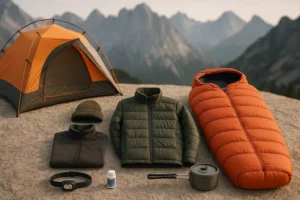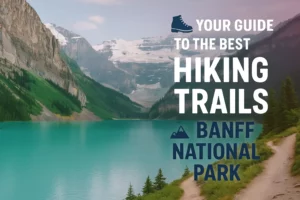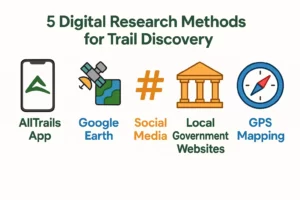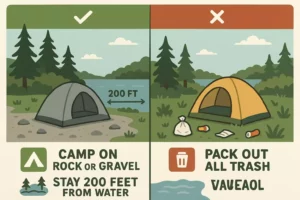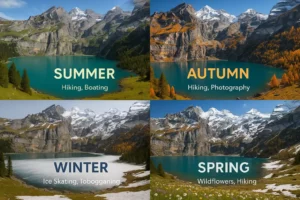Hiking the Colorado Trail: Essential Tips for the 500-Mile Journey
Picture this: 500 miles of pristine wilderness stretching from Denver to Durango, winding through eight mountain ranges and reaching elevations above 13,000 feet. The Colorado Trail stands as one of America’s most spectacular long-distance hiking adventures, challenging thousands of outdoor enthusiasts each year with its breathtaking beauty and demanding terrain. Whether you’re planning a thru-hike or tackling sections over multiple trips, this iconic trail requires careful preparation, unwavering determination, and respect for Colorado’s rugged mountain environment.
Key Takeaways
- Plan for 4-6 weeks to complete the entire trail, with most hikers averaging 15-20 miles per day
- Prepare for extreme weather changes including snow, thunderstorms, and temperature swings from 20°F to 80°F
- Resupply strategy is crucial with 8-10 resupply points needed for food and gear
- Physical conditioning should begin 6 months before your planned departure date
- Permits are required for certain wilderness areas along the trail
Understanding the Colorado Trail
The Colorado Trail spans approximately 486 miles through some of the most spectacular terrain in the Rocky Mountains. Established in 1987, this trail traverses seven National Forests and six Wilderness Areas, offering hikers an unparalleled journey through Colorado’s diverse ecosystems.
Trail Statistics and Overview
| Aspect | Details |
|---|---|
| Total Distance | 486 miles (782 km) |
| Elevation Gain | 89,000+ feet |
| Highest Point | 13,271 feet (Coney Summit) |
| Lowest Point | 5,500 feet (Chatfield State Park) |
| Average Completion Time | 4-6 weeks |
| Best Hiking Season | July – September |
The trail is divided into 28 segments, making it accessible for both section hikers and thru-hikers. Each segment ranges from 8 to 33 miles, with designated trailheads and access points for resupply and emergency exits.
Essential Pre-Trip Planning
Physical Preparation 🏃♂️
Start training at least 6 months before your planned departure. The Colorado Trail demands exceptional physical fitness due to high altitude, steep terrain, and long daily distances.
Training Regimen:
- Cardiovascular fitness: Run, bike, or hike 4-5 times per week
- Strength training: Focus on legs, core, and back muscles
- Hiking with weight: Gradually increase pack weight to 35-40 pounds
- Altitude preparation: Train at elevation when possible or arrive early to acclimatize
Route Planning and Timing
Optimal hiking season runs from early July through September, though snow can persist at high elevations well into July. Weather windows are short, making timing crucial for success.
Monthly Considerations:
- July: Snow may linger above 11,000 feet; afternoon thunderstorms common
- August: Peak season with best weather conditions
- September: Cooler temperatures, potential early snow, fewer crowds
Colorado Trail Resupply Planner
Recommended Resupply Strategy
Gear and Equipment Essentials
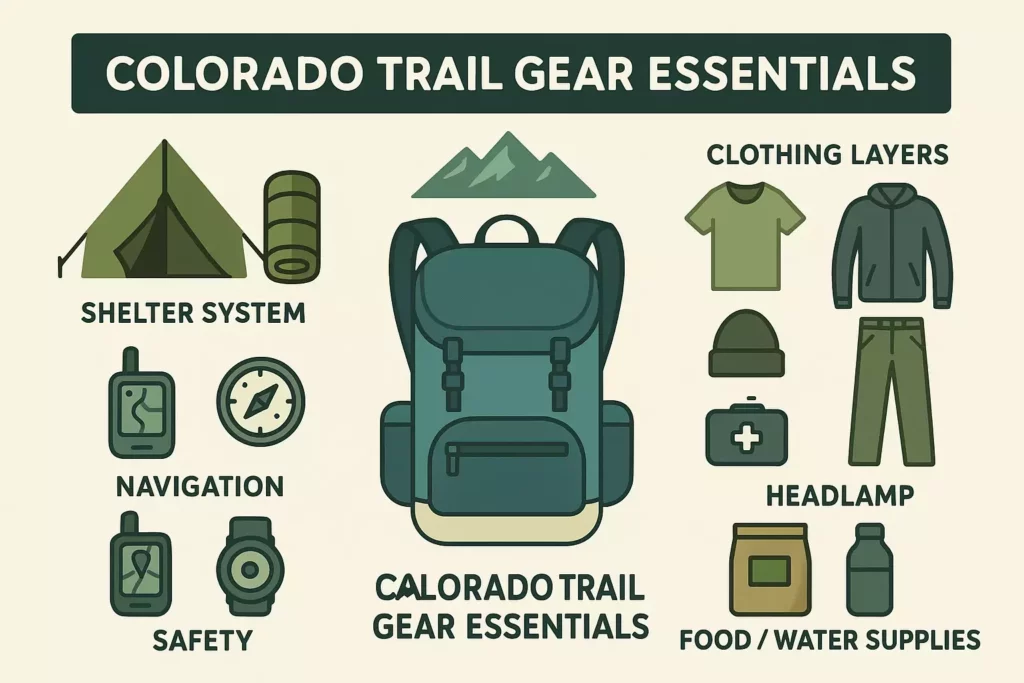
Backpacking Fundamentals
Proper gear selection can make or break your Colorado Trail experience. The extreme elevation changes and unpredictable weather demand versatile, high-quality equipment.
Essential Gear Categories:
Shelter System 🏕️
- Four-season tent or ultralight shelter rated for wind and snow
- Sleeping bag rated to 20°F (temperatures can drop unexpectedly)
- Insulated sleeping pad with R-value of 4+ for ground insulation
For comprehensive guidance on how to pick a sleeping bag for camping, consider factors like temperature rating, weight, and packability specific to high-altitude conditions.
Clothing System
- Base layers: Merino wool or synthetic materials
- Insulation layer: Down or synthetic puffy jacket
- Shell layer: Waterproof, breathable rain gear
- Multiple pairs of hiking socks and underwear
Learn more about selecting appropriate cool weather clothes for camping to handle Colorado’s variable mountain conditions.
Navigation and Safety Equipment
Navigation Tools:
- GPS device with preloaded trail maps
- Paper maps and compass as backup
- Emergency communication device (satellite messenger)
Safety Essentials:
Building a comprehensive first aid kit is crucial for remote trail sections where help may be hours or days away.
Critical Safety Items:
- Comprehensive first aid kit with altitude sickness medication
- Water purification system (filter + backup tablets)
- Emergency shelter (bivy or emergency blanket)
- Headlamp with extra batteries
- Sun protection (sunglasses, hat, SPF 30+ sunscreen)
Water and Food Strategy
Water Sources and Purification
Water availability varies dramatically across the trail’s 28 segments. Some sections offer abundant streams, while others require careful planning for dry stretches.
Water Purification Methods:
- Filtration system: Lightweight filter for clear mountain streams
- Purification tablets: Backup for questionable water sources
- UV sterilizer: Fast treatment for large volumes
For detailed information on how to purify water for drinking while camping, explore various methods suitable for backcountry conditions.
Food Planning and Resupply
Caloric Requirements:
- 4,000-5,000 calories per day due to high altitude and strenuous activity
- Lightweight, calorie-dense foods to minimize pack weight
- Variety to prevent food fatigue over weeks of hiking
Resupply Strategy:
- Mail drops to post offices or businesses along the route
- Purchase supplies in trail towns when possible
- Cache food at accessible road crossings (with permission)
Popular Resupply Towns:
- Breckenridge (Mile 150)
- Leadville (Mile 235)
- Twin Lakes (Mile 285)
- Lake City (Mile 400)
- Silverton (Mile 450)
Packing and Organization
Pack Selection and Loading
Backpack capacity should range from 60-80 liters for thru-hikers, depending on resupply strategy and personal gear preferences.
For expert advice on how to pack your backpack for camping, focus on weight distribution and accessibility of essential items.
Packing Principles:
- Heavy items close to your back and centered
- Frequently used items in easily accessible pockets
- Waterproof stuff sacks to organize and protect gear
- Bear canister or rope for food storage in wilderness areas
Weight Management
Target pack weight should not exceed 20-25% of your body weight when fully loaded with food and water.
Weight-Saving Strategies:
- Ultralight gear where budget allows
- Multi-use items (trekking poles that double as tent poles)
- Minimal redundancy except for critical safety items
- Regular gear shakedowns to eliminate unnecessary items
Weather and Environmental Challenges
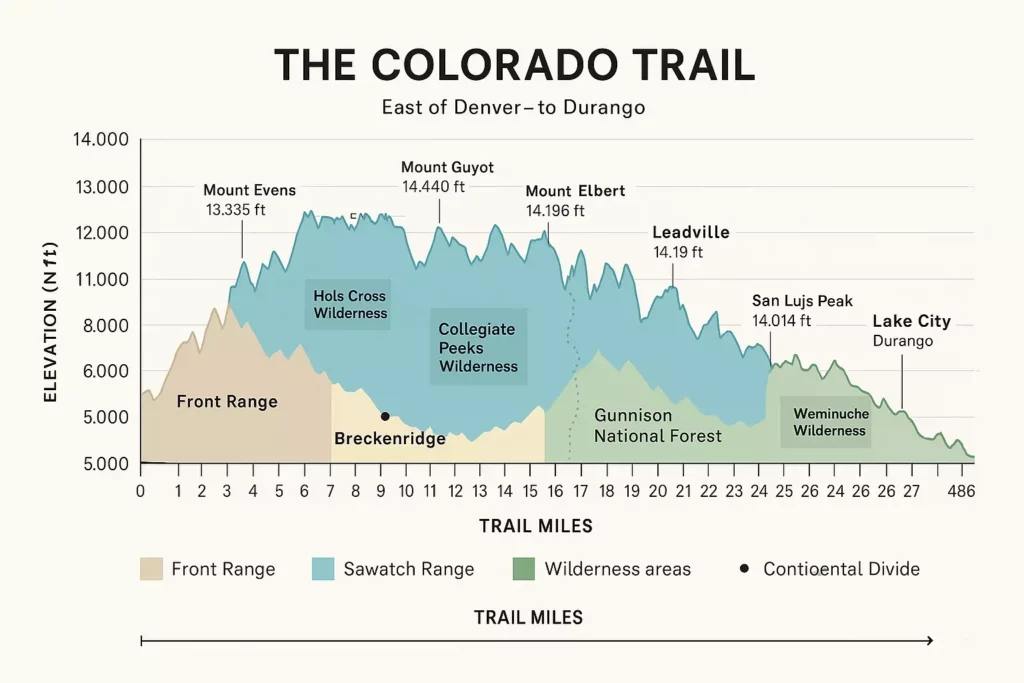
High Altitude Considerations ⛰️
Altitude effects begin around 8,000 feet, with the Colorado Trail spending most of its distance above 10,000 feet.
Altitude Sickness Prevention:
- Gradual ascent when possible
- Stay hydrated (drink 3-4 liters daily)
- Recognize symptoms: headache, nausea, fatigue
- Descend immediately if symptoms worsen
Weather Patterns and Hazards
Afternoon thunderstorms are common and dangerous above treeline. Plan to reach high passes early in the day, typically before noon.
Weather Hazards:
- Lightning strikes on exposed ridges
- Flash floods in narrow valleys
- Sudden temperature drops of 40°F or more
- Snow possible any month of the year
Weather Monitoring:
- Check forecasts daily when possible
- Carry weather radio for severe weather alerts
- Plan escape routes from exposed terrain
- Turn back when conditions deteriorate
Wildlife and Environmental Safety
Bear Safety 🐻
Black bears are common along the Colorado Trail, requiring proper food storage and awareness.
Bear Safety Protocol:
- Store food in bear canisters or hang properly
- Cook and eat away from sleeping areas
- Keep a clean camp with no food odors
- Make noise while hiking to avoid surprising bears
For wilderness preparedness, consider building a bushcraft survival kit for camping that includes bear deterrents and emergency signaling devices.
Mountain Lions and Other Wildlife
Mountain lions inhabit the trail corridor but encounters are rare. Elk, moose, and mountain goats pose greater risks during rutting season or when protecting young.
Wildlife Encounter Guidelines:
- Maintain distance from all wildlife
- Never feed wild animals
- Store scented items with food
- Report aggressive animal behavior to authorities
Training and Conditioning
Physical Preparation Timeline
6 Months Before:
- Begin cardiovascular training program
- Start hiking with gradually increasing distances
- Incorporate strength training focused on legs and core
3 Months Before:
- Increase training intensity and frequency
- Begin hiking with full pack weight
- Test all gear during overnight trips
1 Month Before:
- Taper training to avoid injury
- Complete final gear shakedown
- Finalize resupply arrangements
Mental Preparation
Mental toughness proves as important as physical fitness on long-distance trails.
Psychological Strategies:
- Set realistic daily goals and celebrate achievements
- Practice mindfulness to manage discomfort and frustration
- Develop contingency plans for various scenarios
- Maintain flexibility when plans change
Trail Etiquette and Leave No Trace
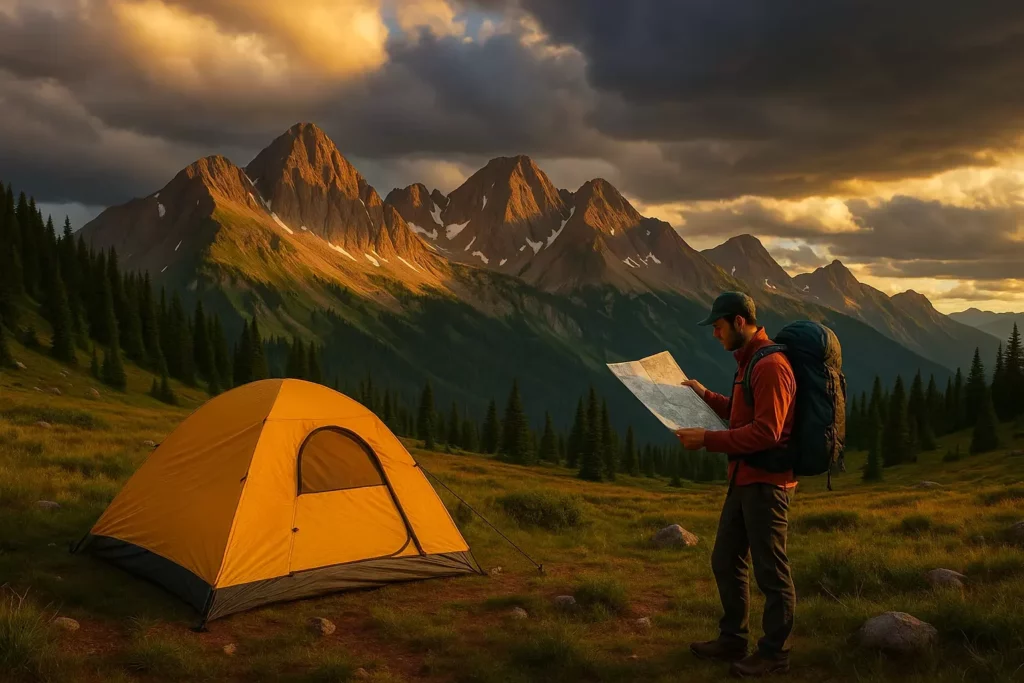
Wilderness Ethics
Leave No Trace principles are essential for preserving the Colorado Trail’s pristine environment for future generations.
Core Principles:
- Plan ahead and prepare properly
- Travel and camp on durable surfaces
- Dispose of waste properly (pack out all trash)
- Leave what you find (no souvenirs)
- Minimize campfire impacts
- Respect wildlife and other visitors
- Be considerate of other hikers
Campsite Selection
Established campsites should be used when available to minimize environmental impact.
Campsite Guidelines:
- Camp 200 feet from water sources
- Use existing fire rings when available
- Choose durable surfaces like rock or gravel
- Avoid fragile vegetation and meadows
Emergency Preparedness and Communication
Emergency Planning
Communication strategy is vital given the remote nature of many trail sections.
Emergency Communication:
- Satellite messenger for two-way communication
- Personal locator beacon for life-threatening emergencies
- Cell phone (limited coverage in mountains)
- Emergency whistle for signaling nearby help
Evacuation Routes
Know your exit options for each trail segment in case of emergency, injury, or severe weather.
Common Evacuation Points:
- Road crossings every 15-30 miles
- Trailheads accessing populated areas
- Mountain passes with vehicle access
- Ski areas during summer operations
Permits and Regulations
Required Permits
Wilderness permits are required for overnight camping in certain areas along the Colorado Trail.
Permit Requirements:
- Holy Cross Wilderness (Segments 9-10)
- Collegiate Peaks Wilderness (Segments 13-15)
- Weminuche Wilderness (Segments 25-27)
Regulations and Restrictions
Fire restrictions are common during dry conditions, potentially prohibiting all open flames including camp stoves in extreme cases.
Common Restrictions:
- No camping within 100 feet of water sources
- Group size limits (typically 12 people maximum)
- Stock restrictions in certain wilderness areas
- Seasonal closures for wildlife protection
Section Hiking Alternatives
Popular Segments for Beginners
Not everyone needs to attempt the full 500-mile journey. Section hiking allows experience building and schedule flexibility.
Recommended Beginner Segments:
- Segment 1-2: Waterton Canyon to South Platte River (25 miles)
- Segment 6: Long Gulch to Kenosha Pass (32 miles)
- Segment 24: Spring Creek Pass to San Luis Pass (14 miles)
Multi-Year Approaches
Completing the trail over several years provides flexibility for work and family commitments while building experience.
Strategic Section Planning:
- Year 1: Segments 1-10 (Denver to Copper Mountain)
- Year 2: Segments 11-20 (Copper Mountain to Marshall Pass)
- Year 3: Segments 21-28 (Marshall Pass to Durango)
Technology and Apps
Helpful Trail Apps
Modern technology enhances safety and navigation when used appropriately.
Recommended Apps:
- Guthook Guides: Detailed trail maps with water sources and campsites
- Weather Underground: Accurate mountain weather forecasts
- AllTrails: Offline maps and trail conditions
- First Aid by Red Cross: Emergency medical guidance
GPS and Mapping
GPS devices provide reliable navigation backup to smartphone apps.
GPS Considerations:
- Battery life in cold mountain conditions
- Accuracy in deep valleys and heavy tree cover
- Map updates with current trail conditions
- Waypoint marking for water sources and campsites
Conclusion
The Colorado Trail represents one of America’s premier long-distance hiking challenges, demanding thorough preparation, physical fitness, and mental resilience. Success depends on meticulous planning, quality gear selection, and respect for the mountain environment’s inherent dangers and beauty.
Your next steps should include:
- Assess your fitness level and begin a structured training program at least six months before your planned departure
- Research and purchase essential gear, testing everything during shorter backpacking trips
- Plan your resupply strategy using the interactive tool above to determine optimal stopping points
- Obtain necessary permits for wilderness areas along your intended route
- Connect with the Colorado Trail community through online forums and local hiking groups for current conditions and advice
Whether you choose to tackle the entire trail in one epic journey or savor it through section hikes over multiple years, the Colorado Trail offers an unforgettable adventure through some of America’s most spectacular mountain wilderness. With proper preparation and respect for the challenges ahead, you’ll join the ranks of hikers who have experienced this remarkable 500-mile journey through the heart of the Rocky Mountains.
Remember that every successful Colorado Trail hike begins with a single step – start planning today, and you’ll be ready to take that first step from Waterton Canyon toward the adventure of a lifetime.

